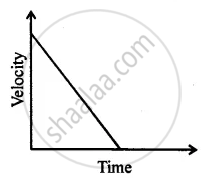Advertisements
Advertisements
Question
A body is thrown vertically upward with velocity u, the greatest height h to which it will rise is,
Options
`"u"/"g"`
`"u"^2/(2"g")`
`"u"^2/"g"`
`"u"/(2"g")`
Solution
`"u"^2/(2"g")`
At highest point, v = 0
Using v2– u2 = 2as, we get
0 − u2 = 2(−g)h ( ∵ a = −g and s = h)
or h = `"u"^2/(2"g")`
APPEARS IN
RELATED QUESTIONS
Define velocity. What is the SI unit of velocity ?
Explain why, the motion of a body which is moving with constant speed in a circular path is said to be accelerated.
Describe the motion of a body which is accelerating at a constant rate of 10 m s–2. If the body starts from rest, how much distance will it cover in 2 s ?
A motorcycle moving with a speed of 5 m/s is subjected to an acceleration of 0.2 m/s2. Calculate the speed of the motorcycle after 10 seconds, and the distance travelled in this time.
A train travelling at 20 m s-1 accelerates at 0.5 m s-2 for 30 s. How far will it travel in this time ?
Derive the formula s= `ut+1/2at^2` , where the symbols have usual meanings.
A car is travelling along the road at 8 ms-1. It accelerates at 1 ms-2 for a distance of 18 m. How fast is it then travelling ?
The slope of a speed-time graph gives:
How can you find the following?
Velocity from acceleration – time graph.
Can you suggest a real-life example about the motion of a body from the following velocity – time graph?

